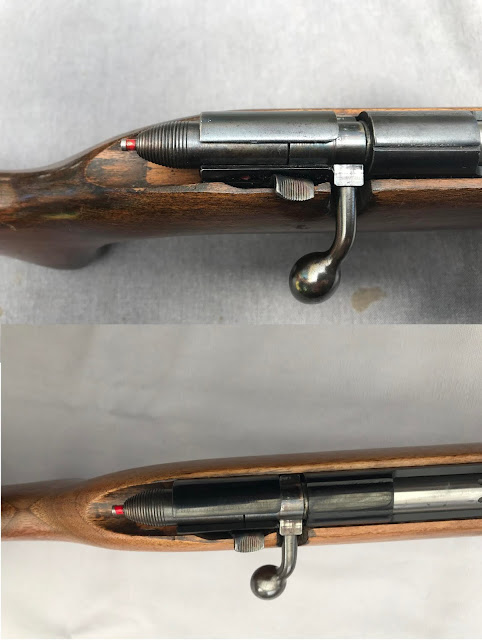The Marlin model of 1881 was not the first lever action rifle, nor was it Marlin's first rifle. It was however the first Marlin lever action rifle, in fact it was Marlin's first repeating rifle.
We could begin this story with the first lever action pistol, then rifle. Or we could begin the story with the several inventors who patented innovations that were used in this rifle.
Instead we will start John Marlin and how he came to be in the lever action rifle business.
John Marlin had worked in the tool and die trade in New England prior to the outbreak of the Civil War. During the war he answered the call for workers at Colt's Patent Fire Arms Manufacturing Company in Hartford. He stayed on after the war, learning as much as he could about the gun business.
In 1870 he set out on his own and founded the Marlin Firearms Company in New Haven. The choice of New Haven may seem obvious to us today. Rival gun maker Winchester had established a factory there, but was still a small company with only a few models in 1870. The gun that put Winchester on the map had not yet been developed (the model of 1873).
Marlin began by making single shot rimfire pistols, which led to revolvers which led to single shot rifles, then Ballard falling block rifles....the next progression was to a repeating rifle.
Marlin-Ballard Single Shot Falling Block circa 1876
Marlin had patented several innovations during the 1870s & 1880's. In addition he entered into agreements to pay Andrew Burgess, H.F. Wheeler and E.A.F. Topperwein for their patented features.
photo courtesy of Marlin Firearms by William S. Brophy
Originally the gun was not called the model of 1881, it didn't get that moniker until 1888. Between 1881 and 1888 It was called the "Marlin Repeater", "The Marlin Magazine Gun" or simply the "Marlin Rifle".
Below is a picture of serial number 1. This is the first repeating rifle made by Marlin, the very first production model.....
This gun was on loan to the Cody Firearms Museum for a number of years before being put up for auction by the Marlin Firearms Company in 2007.
Here is a picture from the auction site, the gun sold for $103,500.00
Let's take a moment and think about what changes this gun has seen. It was built in 1881 by John Marlin's own hands. It saw the creation of the Marlin logo in 1889. It was still in the hands of the company when John Marlin died in 1901.
It was still there in New Haven when the company was purchased by investors in 1915. It was there while the U.S. went to war in Europe for the first time.
It was still there in 1924 when the assets of the failed Marlin company were purchased by Frank Kenna for $100.
It was there for the Great Depression......and when the U.S. went to war in the Pacific and Europe (again).
It was there while the Marlin model 60 was being designed in 1959.
It moved with the company in 1969 from New Haven to North Haven......but when Remington's Freedom Group purchased the company, old number one had to go.
It was sold before the North Haven plant closed in 2010.
Back to our story:
In the first year in was introduced only the .45-70 and .40-60 calibers were offered. The only barrel length available was 28". Although other barrel lengths were eventually offered, the vast majority were in 28" and 24".
The catalog price in 1881/1882 was $32, which is worth approximately $805.50 in 2019 dollars. That is not too expensive considering the comparable Marlin today (Spring of 2021) would cost you $1,099.99.
ad courtesy of the Sportsman Outdoor Superstore
This price was reduced over the years, perhaps as an attempt to find the market price or it was due to efficiencies in mass producing the gun. By 1888 the price had been reduced to $22.50 ($627 in 2021 quid).
I have read that John Marlin's hopes were to acquire a military contract (I suppose that is true of every gunmaker) and in 1882 the U.S. Military did consider the gun.
In the end the price and complexity of the gun, kept the Springfield Trapdoor as the service rifle for another 11 years.
The model of 1881 was supplemented with another lever action repeater in 1888, chambered for the smaller pistol calibers that Marlin condemned in their early adds for the model of 1881.
Eventually sales slowed down for the model 1881, between 1892 and 1903 (when it was removed from the catalog) only 16 model of 1881s were shipped.
Specs:
Action: Lever Action, tube magazine fed repeater
Calibers: .40-60, .45-70, .38-55, .32-40 & .45-85
Capacity: 8-10 depending on caliber & barrel length
Overall Length: 38-52" depending on barrel length
Weight: 7.5-11 lbs depending on caliber & barrel length
Barrel Length: 20-34"
Years Produced: 1881-1903
Qty Produced: 20,535
This post was inspired by a gun that I owned for a time. The rifle below was built in 1886 and featured the .24" heavy octagon barrel (cut down from 28"), chambered in .45 Govt.
An interesting side note, when this gun was built a man by the name of Carl Gustave Swebilius was working at Marlin as a barrel driller. He later started High Standard. It is entirely possible that the barrel of this rifle was drilled by Swebilius
Sources:
Brophy, William S. (1989) Marlin Firearms: A History of the Guns and the Company that made them. Mechanicsburg, PA: Stackpole Books
https://truewestmagazine.com/1881-marlin-rifle/
https://www.historynet.com/challenge-repeated-1881-marlin-rifle.htm
http://www.nramuseum.org/guns/the-galleries/the-american-west-1850-to-1900/case-19-smith-wesson,-marlin,-remington-and-others/marlin-model-1881-lever-action-rifle.aspx
http://www.marlin-collectors.com/forum/viewtopic.php?t=2592
http://www.lasc.us/FryxellStoryofMarlin.htm
https://www.morphyauctions.com/jamesdjulia/item/lot-2321-exceptionally-rare-and-unique-marlin-model-1881-very-first-marlin-lever-action-rifle-produced-31616/
https://www.turnbullrestoration.com/gun/marlin-model-1881-factory-engraved-gold-plated/
https://www.sportsmansoutdoorsuperstore.com/products2.cfm/ID/32293
Sources:
Brophy, William S. (1989) Marlin Firearms: A History of the Guns and the Company that made them. Mechanicsburg, PA: Stackpole Books
https://truewestmagazine.com/1881-marlin-rifle/
https://www.historynet.com/challenge-repeated-1881-marlin-rifle.htm
http://www.nramuseum.org/guns/the-galleries/the-american-west-1850-to-1900/case-19-smith-wesson,-marlin,-remington-and-others/marlin-model-1881-lever-action-rifle.aspx
http://www.marlin-collectors.com/forum/viewtopic.php?t=2592
http://www.lasc.us/FryxellStoryofMarlin.htm
https://www.morphyauctions.com/jamesdjulia/item/lot-2321-exceptionally-rare-and-unique-marlin-model-1881-very-first-marlin-lever-action-rifle-produced-31616/
https://www.turnbullrestoration.com/gun/marlin-model-1881-factory-engraved-gold-plated/
https://www.sportsmansoutdoorsuperstore.com/products2.cfm/ID/32293













































































